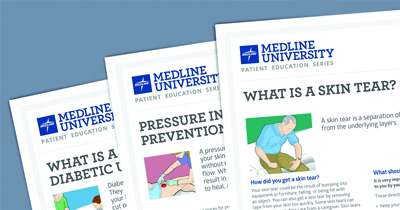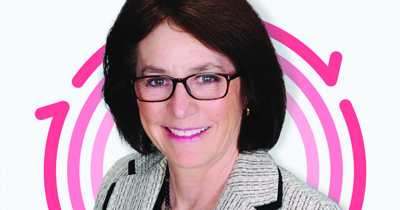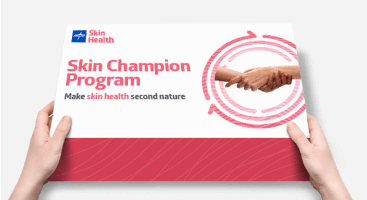Tips to help protect fragile skin across the patient journey
Tools and strategies to help protect skin across the continuum of care.
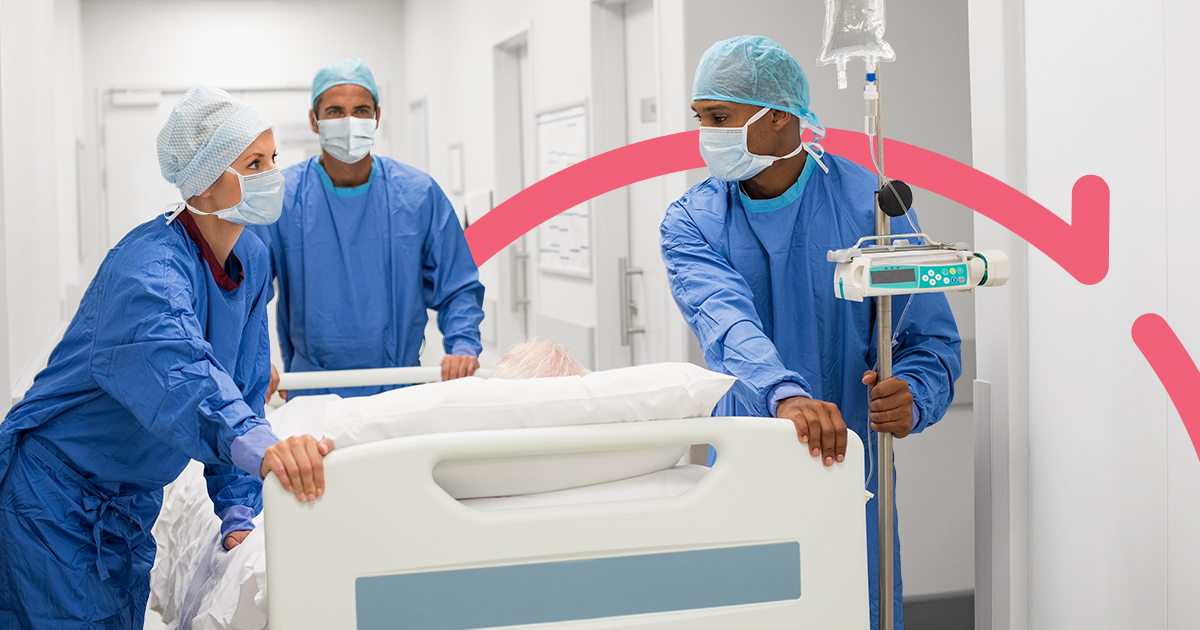
Various obstacles can get in the way of providing consistent skin health across the patient journey, especially with the added challenges of COVID-19. But inconsistencies can lead to skin breakdown and ultimately readmissions to acute care facilities.
Research shows that among patients with a healthcare associated pressure injury, 25.5% were readmitted within 30 days, 36.6% by 90 days, and 42.7% by 180 days; these numbers were all higher than in patients without HAPIs.¹ That’s why it’s important to prevent pressure injuries from happening in the first place.
42.7%
of patients with a HAPI are readmitted within 180 days¹
You can help reduce those numbers by empowering staff to keep pressure injury prevention top of mind throughout the patient journey, across units and facilities.
Let’s follow our fictional patient, Henry, through the healthcare continuum to see where there are everyday gaps and opportunities to help prevent skin breakdown.
Long waits in the emergency department
Henry is a 75-year-old male, about 5-foot-11 and 310 pounds. His medical history includes diabetes and obesity, urinary incontinence and a history of cardiovascular disease. He is experiencing shortness of breath and chest pain and first comes to the hospital through the emergency department. The physicians conclude Henry needs emergency surgery, but he first spends five hours on a stretcher in the emergency department awaiting admittance.
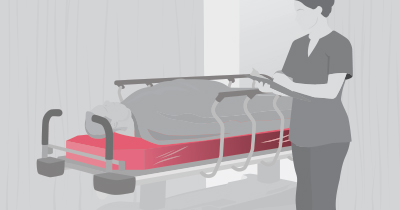
Henry’s wait time is actually pretty average. Some patients spend longer there, especially with staff shortages and now more critically ill patients. Waiting for a clinician or specialist can mean longer time with unrelieved pressure on a hard surface. Unrelieved pressure is directly related to skin and soft tissue damage. Here’s what you should know to help keep people safe:
PI Prevention tips in the ED:
- Choose stretcher pads that help reduce and redistribute pressure on fragile skin.
- Turn patients frequently, using a repositioning system to reduce risk of friction and shear.
Risks of injury in the operating room
During his four-hour coronary artery bypass graft, Henry is completely immobile on a hard table. Did you know pressure injuries can develop in as little as two hours? That means Henry’s skin is extra-vulnerable at this point.² Before he goes in for the surgery, check that all pressure injury prevention strategies have been implemented.
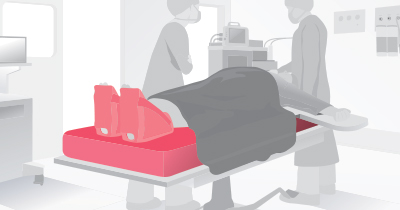
Did you know pressure injuries can develop in as little as two hours?²
PI Prevention tips in the OR:
- Use OR table pads that reduce pressure and keep skin cool and dry.
- Position medical devices, such as tubing devices and intravenous catheters, to reduce the risk of a medical device-related pressure injury. Move them out from under patients whenever possible.
- Offload heels according to National Pressure Injury Advisory Panel guidelines. Specially designed heel suspension devices will distribute the weight of the leg along the calf without placing too much pressure on the Achilles tendon and the popliteal vein, a major lower body blood vessel.
- Protect the sacrum and other bony prominences with a 5-layer foam dressing that can help control friction and shear and manage microclimate.
Skin health challenges of the intensive care unit
During Henry’s surgery, there was a complication controlling his blood glucose levels. He’s now in the ICU, sedated and ventilated, experiencing both urinary and fecal incontinence. All these factors put him at an even higher risk for skin breakdown.
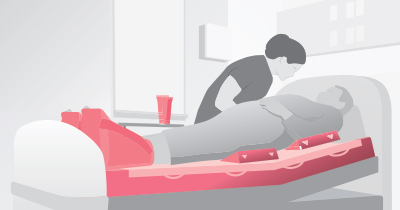
PI prevention tips in the ICU:
- Reduce pressure on vulnerable areas with skin-friendly support surfaces. Also, be sure to add your expert voice to any discussion regarding the selection of new support surfaces and the inspection of existing ones. The condition of your facility support surfaces should be checked regularly.
- Protect patients’ skin from the risk of injury due to incontinence-associated dermatitis with advanced skin care and a breathable, long-lasting barrier.
- Continue to protect bony prominences with specially designed dressings.
- Turn and reposition patients frequently and safely, with a complete system of products that includes repositioning sheets, wedges and ultra-absorbent drypads to help manage moisture.
Critical additional recovery time
Henry’s blood glucose has stabilized, and he’s been moved to the medical-surgical unit for another day of recovery. Although he’s able to reposition himself a bit better, his skin is still fragile due to limited mobility, urinary incontinence and risk of moisture in skinfolds. For this reason, keeping skin dry is crucial. An antibacterial wicking sheet such as DriGo-HP can help.
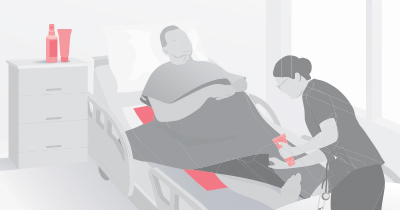
Two steps before hospital discharge
Henry has been cleared to go to a skilled nursing facility, with a plan for continued care. But before he leaves the hospital, be sure these two items are complete:
- Complete a skin assessment. Just like you assess a patient’s skin upon admission, it’s equally important to do the same upon discharge. A comprehensive skin assessment will alert healthcare providers along the patient’s journey to any special areas to keep an eye on. It also will help dictate the proper skin care products, support surfaces or dressings the patient will need.
- Communicate effectively. No matter where your patients go next, their full health story should go with them. The American Society for Health Care Risk Management (ASHRM) suggests “a structured handoff tool” such as the situation-background-assessment-recommendation (SBAR). This kind of detailed documentation includes important skin health data and information needed to choose appropriate surfaces for Henry when he’s transferred. Experts at ASHRM recommend both electronic and written records to make sure all essential information is received and understood.³
Continuing care beyond the post-acute transition
Now that Henry has entered long-term care, he’ll require a caregiver to monitor his skin health. Quality support surfaces and effective moisture management products will be key factors to Henry’s healing process. Here are some important ways to help prevent skin breakdown:
- Apply an antibacterial wicking sheet to skinfolds and creases to shield them from skin-on-skin friction and moisture that may increase the likelihood of intertriginous dermatitis (ITD).
- Cleanse, protect and moisturize sensitive skin several times a day and after each incontinence episode. Our pH-balanced system of products can help, with color-coded packaging for easy selection. There may be a set time for trips to the bathroom, but if Henry is mobile enough, encourage him to get up to go when necessary to avoid moisture on his fragile skin.
- Monitor Henry’s intake of food and water. Adequate nutrition is an important factor in healing as well. Bariatric patients can be malnourished. If you’re concerned with his protein intake, talk with the care team about clinical nutrition.
Keeping skin healthy takes a holistic approach and good communication among caregivers during each phase of the healthcare journey.
Key takeaway
Preventing healthcare-associated pressure injuries can also prevent hospital readmissions. As a skin and wound care expert, you play a crucial role in seeing each individual throughout the continuum, from their entrance into care to discharge to post-acute care. When it comes to standardizing practices across care settings, empowering frontline staff is the key to driving better outcomes.
References:
- Wassel, C. L. (2020, December 1). “Risk of readmissions, mortality, and hospital-acquired conditions across hospital-acquired pressure injury (HAPI) stages in a US National Hospital Discharge database.” Wiley Online Library. Available at https://onlinelibrary.wiley.com/doi/full/10.1111/iwj.13482
- Stojadinovic O, Minkiewicz J, Sawaya A, et al. “Deep Tissue Injury in Development of Pressure Ulcers: A Decrease of Inflammasome Activation and Changes in Human Skin Morphology in Response to Aging and Mechanical Load.” PLoS ONE. 2013;8(8): e69223. Available at https://doi.org/10.1371/journal.pone.0069223
- Connelly, R. N. N. (2020, June 26). Improving Transfer Communication between Hospitals and Post-Acute Facilities. ASHRM. Available at https://forum.ashrm.org/2020/06/24/achieving-effective-communication-between-hospitals-and-post-acute-facilities/
